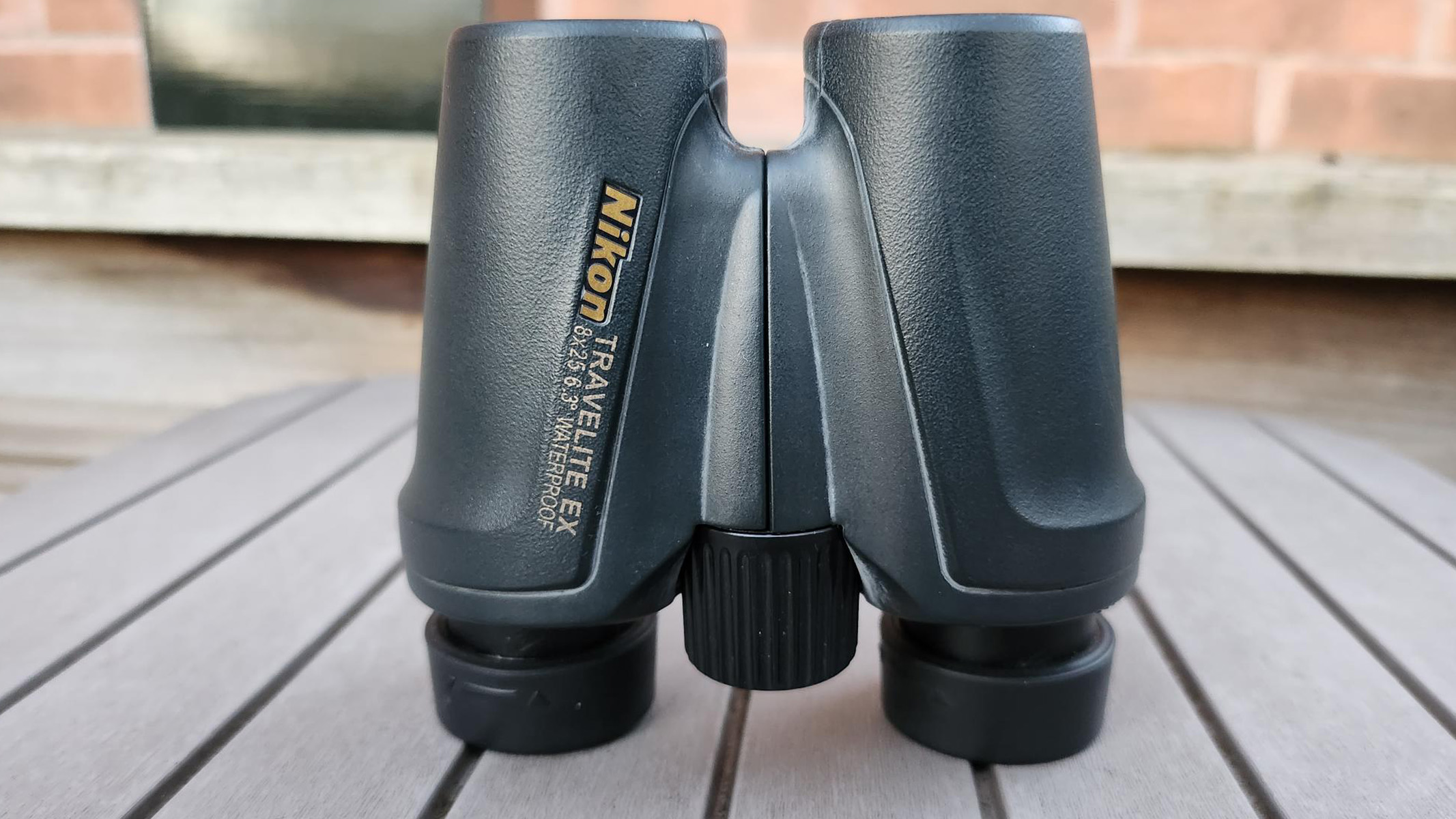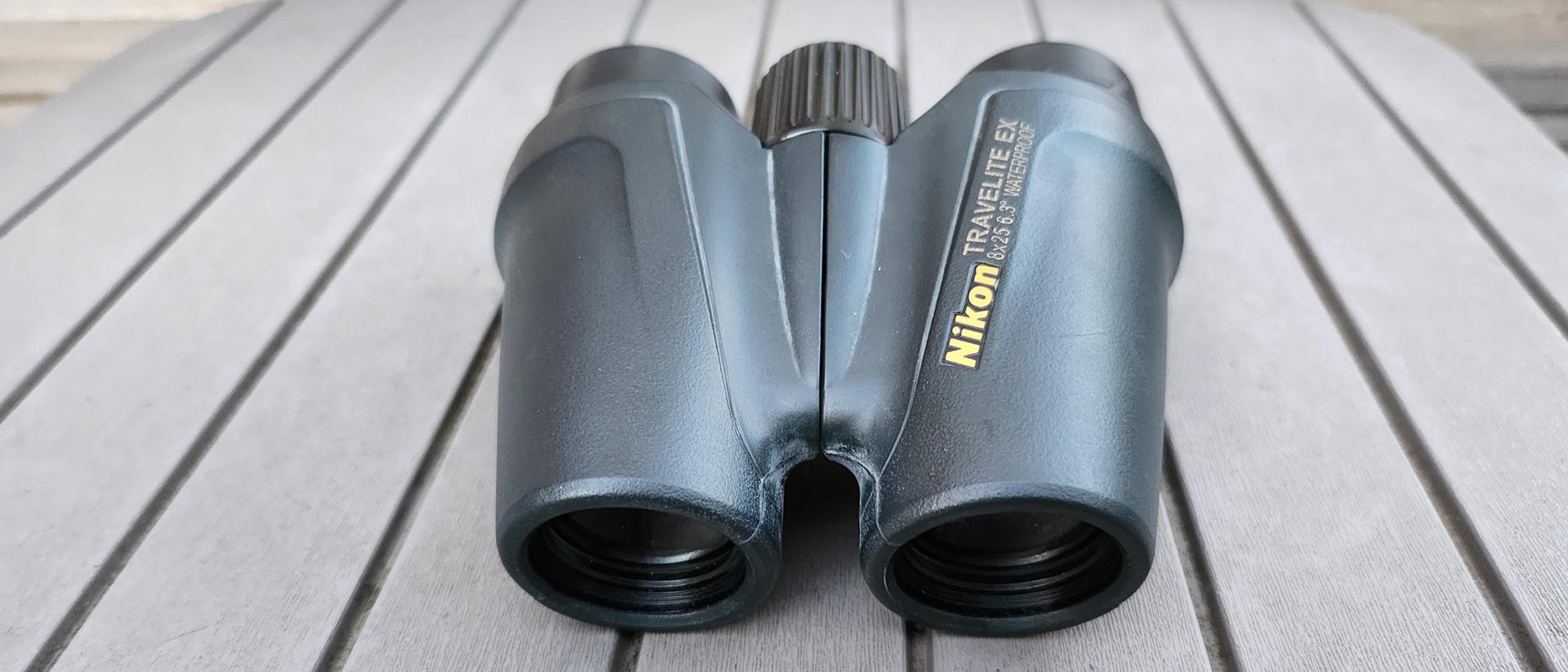Space Verdict
These pocket-sized binoculars are compact, well made and lightweight, making them a handy accessory, but unfortunately — due to their small 25mm aperture — we could not see much celestial detail.
Pros
- +
Pinsharp, crystal clear images
- +
Compact design, suitable for travel
- +
Wide field of view
Cons
- -
The aperture is too small for much astronomy
- -
Expensive, you can get more powerful binoculars for a similar price
Why you can trust Space.com
The Nikon Travelite EX 8x25 binoculars are clearly multi-purpose daytime binoculars, so if you're out and about on a nature walk, watching a sporting event or just doing some sightseeing, these are perfect. However, when the sun sets and the night comes, how do they perform?
Typically 10x50 binoculars are recommended for skywatching, but the 25mm aperture of these Nikon Travelite binocular lenses are just half the diameter. We weren't expecting an outstanding performance from these binoculars when we pointed them at the stars, but we were pleasantly surprised.
Nikon Travelite EX 8x25 binoculars review
Nikon Travelite EX 8x25 binoculars: Design

- Sturdy and durable, with a rubberized coating
- Good eye relief for eyeglasses wearers
- Pocketable thanks to its compact design
In hand, Nikon's Travelite EX 8x25 binoculars feel sturdy and well-made, with a lovely rubberized coating making them feel nicely durable. They weigh just 12.5 oz (355 grams) and have dimensions of 4.3 x 4.5 inches (110mm x 116mm), so you can literally put them in your coat pocket making them truly travel-friendly.

Magnification: 8x
Objective lens diameter: 25mm
Angular field of view: 6.2 degrees
Eye relief: 15.5mm / 0.6 inches
Weight: 12.5oz / 355g
The binoculars feature winding eyecups with a reasonably large range of movement, providing 15.5mm (0.6 inches) of eye relief, making these usable (but not perfect) for spectacle wearers. We found we had to wind the eyecups out otherwise the view appears partly obscured. Focusing is smooth thanks to a central dial.
Although our review model did not come with any accessories, the binoculars usually come with a carry case that can attach to your belt, a double eyepiece cover and a neck strap.
Nikon Travelite EX 8x25 binoculars: Performance

- Very good contrast when observing bright objects
- Large field of view
- Optical system offers high-definition views
The field of view of the binoculars at 1000m (1km/0.6 miles) is 110m (361 feet). Since 17.5m at a distance of 1000m corresponds to 1 degree of the night sky, the binoculars give an angular field of view of 6.2 degrees (110 divided by 17.5). For comparison, the angular size of the full Moon in the sky is about half a degree, so in other words, the field of view of the Nikon Travelite EX 8x25 binoculars is 12 full moon widths.
Indeed, when we looked at the Moon on Dec. 27, it was a five-day-old waxing crescent, and the Moon appeared pretty small in the field of view. We could see plenty of craters, most notably on the terminator between lunar day and night, where the interplay of light and shadow is at its greatest.
Breaking space news, the latest updates on rocket launches, skywatching events and more!
We could also make out craters on the illuminated portion of the lunar surface, where the brightness usually affects contrast. In fact, the image contrast through the Nikon Travelite EX 8x25 binoculars seemed a bit better than through Nikon's Prostaff P7 8x42 that we were also testing, with the crater rims better defined.
The fairly large field of view was further brought home when we shifted southeastwards from the moon in Taurus (the Bull) to the constellation of Orion (the Hunter). The three belt stars — called Alnitak, Alnilam and Mintaka — all fit into the field of view, while in the background were many faint pinpricks of light from fainter stars invisible to the unaided eye. Views of the stars were highly defined and sharp.
When viewed through Nikon's Prostaff P7 8x42, or Celestron's UpClose G2 10x50 binoculars that we also had at our disposal, these background stars appeared far more prominent to us, as would be expected from the larger light grasp of the bigger barrels. When looking at Orion's Belt, we could also squeeze in the fuzzy glow of the Great Nebula in Orion at the bottom of the field. The Nikon Travelite EX 8x25 binoculars were able to make out some of the stars of the Trapezium Cluster, though again not nearly as many as the larger and more powerful binoculars.
Nikon Travelite EX 8x25 binoculars: Functionality

- Lacks great light-gathering power but has decent night-sky views
- Lightweight design
- Resistant to fog and water
Despite the lack of light-gathering power, sweeping through the dusty track of the winter Milky Way revealed stunning views filled with stars. The viewing was a pleasant and comfortable observing experience, the binoculars being so light that we barely noticed we were holding them. There's virtually no shake affecting the view, unlike the wobbly-arm syndrome that can affect stargazing through larger but heavier hand-held binoculars, thanks to the featherweight and large field of the Nikon Travelite EX 8x25 binoculars. Meanwhile, we discovered that the eye-relief adjustment and focusing were both super smooth.
The binoculars are waterproof for five minutes up to a depth of 2 meters, which you'll never need to worry about while stargazing (or, to be honest, bird watching, unless you manage to drop them in a pond somehow!).
Perhaps more importantly, O-ring seals and nitrogen gas within the optical system prevent fogging — a design feature we were massively impressed by as we moved from warmer indoor temperatures into the chillier outdoors.
Should you buy the Nikon Travelite EX 8x25 binoculars?
As lovely as these binoculars are, it's hard to get away from the fact that you can buy larger binoculars for a similar price, or at least not much more.
Serious skywatchers, or those looking to take their night-sky observations beyond the casual level, will likely upgrade quickly. However, the Nikon Travelite offers exquisite views of some of the brighter night sky and daytime targets.
The extra aperture really does make a difference for astronomy, as it allows you to see more detail and a wider selection of targets. For example, Jupiter's moons were on the edge of perception in the Nikon Travelite EX 8x25 binoculars, but a pair of 10x50s (or larger) show them clearly.
Saturn was not on show during our testing period, but the Nikon Travelite EX 8x25 binoculars would not be sufficient to show its rings clearly, nor its largest moon, Titan, due to the small aperture of 25mm. Open star clusters are exquisite through the field of view, but the lower light grasp means they don't pop the way they did through the optical system of the Nikon Prostaff P7 8x42.
If you're looking for a pocket-sized all-arounder to engage in casual observing with, then the Nikon Travelite EX 8x25 binoculars are an excellent choice, but if you're planning on using binoculars as your main observing instrument, then you will very quickly find the need for much more powerful binoculars with bigger apertures.
If the Nikon Travelite EX 8x25 binoculars aren't for you
If the Nikon Travelite EX 8x25 aren't for you, and you're looking for something compact, then the Bushnell H20 8x25 or Celestron UpClose G2 10x25 are excellent choices from our pick of the best compact binoculars. They offer a robust design while allowing the flexibility for travel, nature watching and casual skywatching, with superb magnified views.
For binoculars that are designed for night-sky viewing yet are at a fair budget that doesn't break the bank, the Celestron 7x50 Cometron are suitable for observing the moon, stars, bright deep-sky targets and the planets with very good contrast and clarity.
Meanwhile, seasoned and serious sky-watchers will take great delight in the Celestron SkyMaster 25x100 and Celestron SkyMaster 12x60 binoculars, which offer exquisite, high-definition sights — and greater detail of nebulas, planets and galaxies — at reasonable prices, depending on your budget. Be warned though, these beautifully built instruments are heavy and will require a mount and tripod for steady views.

Gemma currently works for the European Space Agency on content, communications and outreach, and was formerly the content director of Space.com, Live Science, science and space magazines How It Works and All About Space, history magazines All About History and History of War as well as Science, Technology, Engineering, Arts and Mathematics (STEAM) kids education brand Future Genius. She is the author of several books including "Quantum Physics in Minutes", "Haynes Owners’ Workshop Manual to the Large Hadron Collider" and "Haynes Owners’ Workshop Manual to the Milky Way". She holds a degree in physical sciences, a Master’s in astrophysics and a PhD in computational astrophysics. She was elected as a fellow of the Royal Astronomical Society in 2011. Previously, she worked for Nature's journal, Scientific Reports, and created scientific industry reports for the Institute of Physics and the British Antarctic Survey. She has covered stories and features for publications such as Physics World, Astronomy Now and Astrobiology Magazine.

